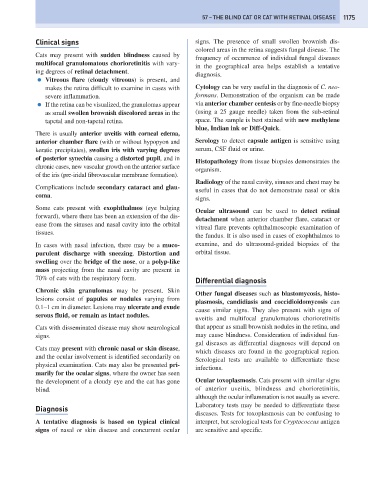Page 1183 - Problem-Based Feline Medicine
P. 1183
57 – THE BLIND CAT OR CAT WITH RETINAL DISEASE 1175
Clinical signs signs. The presence of small swollen brownish dis-
colored areas in the retina suggests fungal disease. The
Cats may present with sudden blindness caused by
frequency of occurrence of individual fungal diseases
multifocal granulomatous chorioretinitis with vary-
in the geographical area helps establish a tentative
ing degrees of retinal detachment.
diagnosis.
● Vitreous flare (cloudy vitreous) is present, and
makes the retina difficult to examine in cases with Cytology can be very useful in the diagnosis of C. neo-
severe inflammation. formans. Demonstration of the organism can be made
● If the retina can be visualized, the granulomas appear via anterior chamber centesis or by fine-needle biopsy
as small swollen brownish discolored areas in the (using a 25 gauge needle) taken from the sub-retinal
tapetal and non-tapetal retina. space. The sample is best stained with new methylene
blue, Indian ink or Diff-Quick.
There is usually anterior uveitis with corneal edema,
anterior chamber flare (with or without hypopyon and Serology to detect capsule antigen is sensitive using
keratic precipitates), swollen iris with varying degrees serum, CSF fluid or urine.
of posterior synechia causing a distorted pupil, and in
Histopathology from tissue biopsies demonstrates the
chronic cases, new vascular growth on the anterior surface
organism.
of the iris (pre-iridal fibrovascular membrane formation).
Radiology of the nasal cavity, sinuses and chest may be
Complications include secondary cataract and glau-
useful in cases that do not demonstrate nasal or skin
coma.
signs.
Some cats present with exophthalmos (eye bulging
Ocular ultrasound can be used to detect retinal
forward), where there has been an extension of the dis-
detachment when anterior chamber flare, cataract or
ease from the sinuses and nasal cavity into the orbital
vitreal flare prevents ophthalmoscopic examination of
tissues.
the fundus. It is also used in cases of exophthalmos to
In cases with nasal infection, there may be a muco- examine, and do ultrasound-guided biopsies of the
purulent discharge with sneezing. Distortion and orbital tissue.
swelling over the bridge of the nose, or a polyp-like
mass projecting from the nasal cavity are present in
70% of cats with the respiratory form. Differential diagnosis
Chronic skin granulomas may be present. Skin
Other fungal diseases such as blastomycosis, histo-
lesions consist of papules or nodules varying from
plasmosis, candidiasis and coccidioidomycosis can
0.1–1 cm in diameter. Lesions may ulcerate and exude
cause similar signs. They also present with signs of
serous fluid, or remain as intact nodules.
uveitis and multifocal granulomatous chorioretinitis
Cats with disseminated disease may show neurological that appear as small brownish nodules in the retina, and
signs. may cause blindness. Consideration of individual fun-
gal diseases as differential diagnoses will depend on
Cats may present with chronic nasal or skin disease,
which diseases are found in the geographical region.
and the ocular involvement is identified secondarily on
Serological tests are available to differentiate these
physical examination. Cats may also be presented pri-
infections.
marily for the ocular signs, where the owner has seen
the development of a cloudy eye and the cat has gone Ocular toxoplasmosis. Cats present with similar signs
blind. of anterior uveitis, blindness and chorioretinitis,
although the ocular inflammation is not usually as severe.
Laboratory tests may be needed to differentiate these
Diagnosis
diseases. Tests for toxoplasmosis can be confusing to
A tentative diagnosis is based on typical clinical interpret, but serological tests for Cryptococcus antigen
signs of nasal or skin disease and concurrent ocular are sensitive and specific.

